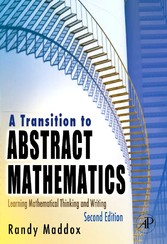Suchen und Finden
Front Cover
1
A Transition to Abstract Mathematics
4
Copyright Page
5
Table of Contents
8
Why Read This Book?
14
Preface
16
Preface to the First Edition
18
Acknowledgments
22
Chapter 0. Notation and Assumptions
24
0.1 Set Terminology and Notation
24
0.2 Assumptions about the Real Numbers
26
0.2.1 Basic Algebraic Properties
26
0.2.2 Ordering Properties
28
0.2.3 Other Assumptions
30
Part 1: Foundations of Logic and ProofWriting
32
Chapter 1. Language and Mathematics
34
1.1 Introduction to Logic
34
1.1.1 Statements
34
1.1.2 Negation of a Statement
36
1.1.3 Combining Statements with AND
36
1.1.4 Combining Statements with OR
37
1.1.5 Logical Equivalence
39
1.1.6 Tautologies and Contradictions
41
1.2 If-Then Statements
41
1.2.1 If-Then Statements Defined
41
1.2.2 Variations on p . q
44
1.2.3 Logical Equivalence and Tautologies
46
1.3 Universal and Existential Quantifiers
50
1.3.1 The Universal Quantifier
51
1.3.2 The Existential Quantifier
52
1.3.3 Unique Existence
55
1.4 Negations of Statements
56
1.4.1 Negations of AND and OR Statements
56
1.4.2 Negations of If-Then Statements
57
1.4.3 Negations of Statements with the Universal Quantifier
59
1.4.4 Negations of Statements with the Existential Quantifier
60
1.5 How We Write Proofs
63
1.5.1 Direct Proof
63
1.5.2 Proof by Contrapositive
64
1.5.3 Proving a Logically Equivalent Statement
64
1.5.4 Proof by Contradiction
65
1.5.5 Disproving a Statement
65
Chapter 2. Properties of Real Numbers
68
2.1 Basic Algebraic Properties of Real Numbers
68
2.1.1 Properties of Addition
69
2.1.2 Properties of Multiplication
72
2.2 Ordering Properties of the Real Numbers
74
2.3 Absolute Value
76
2.4 The Division Algorithm
79
2.5 Divisibility and Prime Numbers
82
Chapter 3. Sets and Their Properties
86
3.1 Set Terminology
86
3.2 Proving Basic Set Properties
90
3.3 Families of Sets
94
3.4 The Principle of Mathematical Induction
101
3.5 Variations of the PMI
108
3.6 Equivalence Relations
114
3.7 Equivalence Classes and Partitions
120
3.8 Building the Rational Numbers
125
3.8.1 Defining Rational Equality
126
3.8.2 Rational Addition and Multiplication
127
3.9 Roots of Real Numbers
129
3.10 Irrational Numbers
130
3.11 Relations in General
134
Chapter 4. Functions
142
4.1 Definition and Examples
142
4.2 One-to-one and Onto Functions
148
4.3 Image and Pre-Image Sets
151
4.4 Composition and Inverse Functions
154
4.4.1 Composition of Functions
155
4.4.2 Inverse Functions
156
4.5 Three Helpful Theorems
158
4.6 Finite Sets
160
4.7 Infinite Sets
162
4.8 Cartesian Products and Cardinality
167
4.8.1 Cartesian Products
167
4.8.2 Functions Between Finite Sets
169
4.8.3 Applications
171
4.9 Combinations and Partitions
174
4.9.1 Combinations
174
4.9.2 Partitioning a Set
175
4.9.3 Applications
176
4.10 The Binomial Theorem
180
Part II: Basic Principles of Analysis
186
Chapter 5: The Real Numbers
188
5.1 The Least Upper Bound Axiom
188
5.1.1 Least Upper Bounds
189
5.1.2 Greatest Lower Bounds
191
5.2 The Archimedean Property
192
5.2.1 Maximum and Minimum of Finite Sets
193
5.3 Open and Closed Sets
195
5.4 Interior, Exterior, Boundary, and Cluster Points
198
5.4.1 Interior, Exterior, and Boundary
198
5.4.2 Cluster Points
199
5.5 Closure of Sets
201
5.6 Compactness
203
Chapter 6. Sequences of Real Numbers
208
6.1 Sequences Defined
208
6.1.1 Monotone Sequences
209
6.1.2 Bounded Sequences
210
6.2 Convergence of Sequences
213
6.2.1 Convergence to a Real Number
213
6.2.2 Convergence to Infinity
219
6.3 The Nested Interval Property
220
6.3.1 From LUB Axiom to NIP
221
6.3.2 The NIP Applied to Subsequences
222
6.3.3 From NIP to LUB Axiom
224
6.4 Cauchy Sequences
225
6.4.1 Convergence of Cauchy Sequences
226
6.4.2 From Completeness to the NIP
228
Chapter 7. Functions of a Real Variable
230
7.1 Bounded and Monotone Functions
230
7.1.1 Bounded Functions
230
7.1.2 Monotone Functions
231
7.2 Limits and Their Basic Properties
233
7.2.1 Definition of Limit
233
7.2.2 Basic Theorems of Limits
236
7.3 More on Limits
240
7.3.1 One-Sided Limits
240
7.3.2 Sequential Limits
241
7.4 Limits Involving Infinity
242
7.4.1 Limits at Infinity
243
7.4.2 Limits of Infinity
245
7.5 Continuity
247
7.5.1 Continuity at a Point
247
7.5.2 Continuity on a Set
251
7.5.3 One-Sided Continuity
253
7.6 Implications of Continuity
254
7.6.1 The Intermediate Value Theorem
254
7.6.2 Continuity and Open Sets
256
7.7 Uniform Continuity
258
7.7.1 Definition and Examples
259
7.7.2 Uniform Continuity and Compact Sets
262
Part III: Basic Principles of Algebra
264
Chapter 8. Groups
266
8.1 Introduction to Groups
266
8.1.1 Basic Characteristics of Algebraic Structures
266
8.1.2 Groups Defined
269
8.1.1 Basic Characteristics of Algebraic Structures
266
8.1.2 Groups Defined
269
8.2 Subgroups
275
8.2.1 Subgroups Defined
275
8.2.2 Generated Subgroups
277
8.2.3 Cyclic Subgroups
278
8.3 Quotient Groups
283
8.3.1 Integers Modulo n
283
8.3.2 Quotient Groups
286
8.3.3 Cosets and Lagrange’s Theorem
290
8.4 Permutation Groups
291
8.4.1 Permutation Groups Defined
291
8.4.2 The Symmetric Group
292
8.4.3 The Alternating Group
294
8.4.4 The Dihedral Group
296
8.5 Normal Subgroups
298
8.6 Group Morphisms
303
Chapter 9. Rings
310
9.1 Rings and Fields
310
9.1.1 Rings Defined
310
9.1.2 Fields Defined
315
9.2 Subrings
316
9.3 Ring Properties
319
9.4 Ring Extensions
324
9.4.1 Adjoining Roots of Ring Elements
324
9.4.2 Polynomial Rings
327
9.4.3 Degree of a Polynomial
328
9.5 Ideals
329
9.6 Generated Ideals
332
9.7 Prime and Maximal Ideals
335
9.8 Integral Domains
337
9.9 Unique Factorization Domains
342
9.10 Principal Ideal Domains
344
9.11 Euclidean Domains
348
9.12 Polynomials over a Field
351
9.13 Polynomials over the Integers
355
9.14 Ring Morphisms
357
9.14.1 Properties of Ring Morphisms
359
9.15 Quotient Rings
362
Index
368
Alle Preise verstehen sich inklusive der gesetzlichen MwSt.







